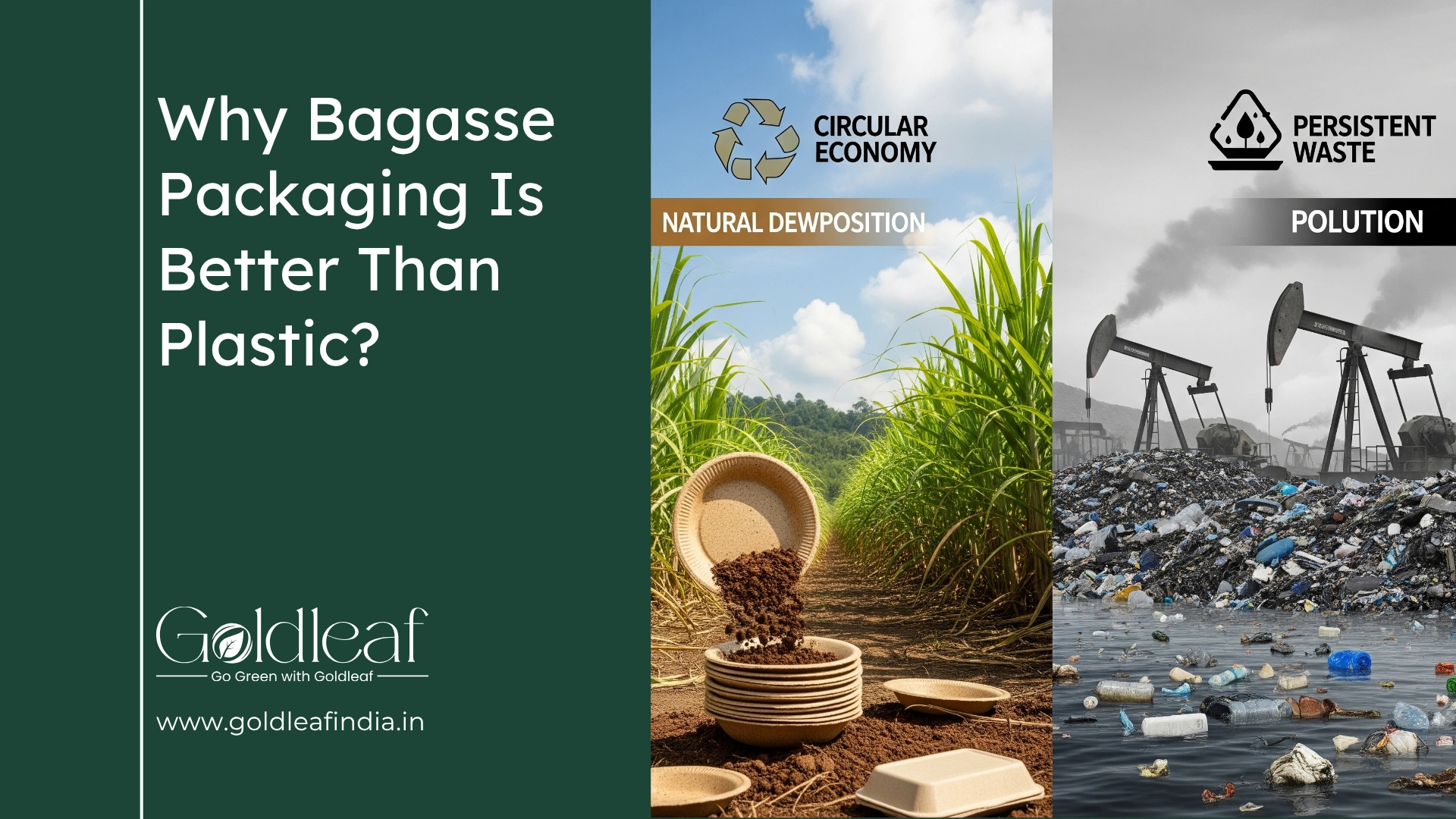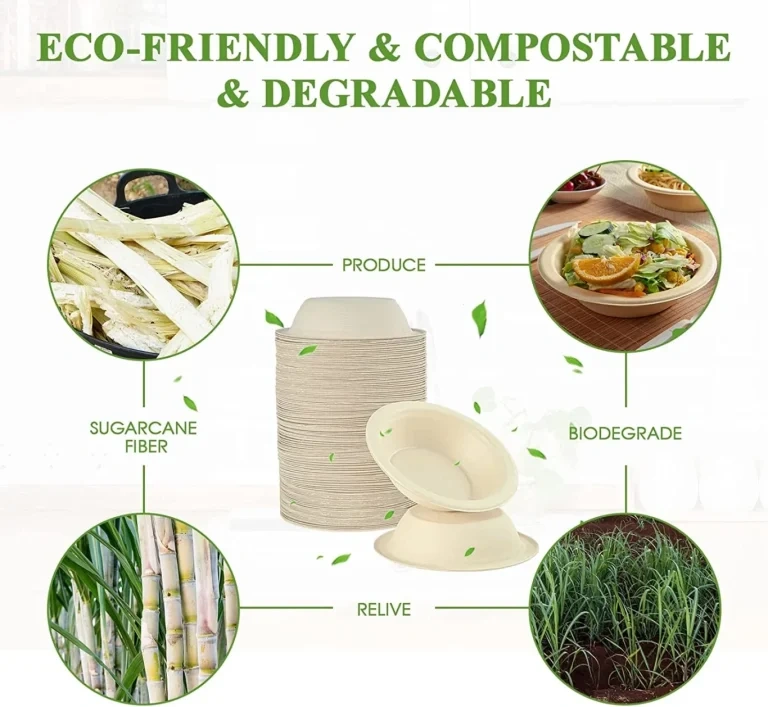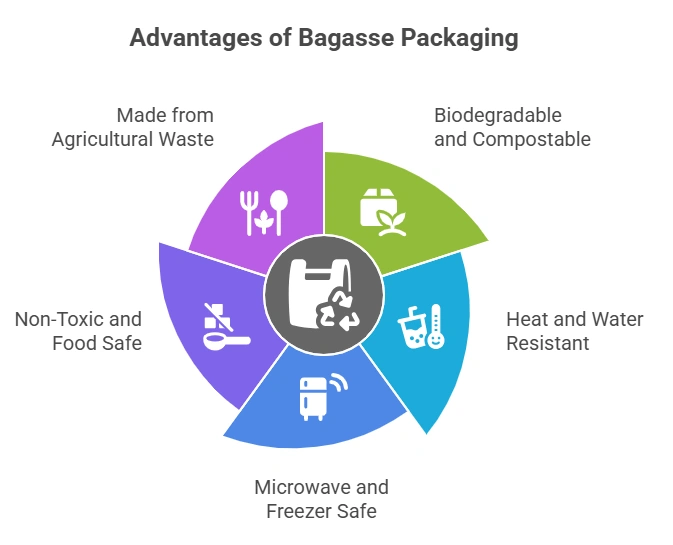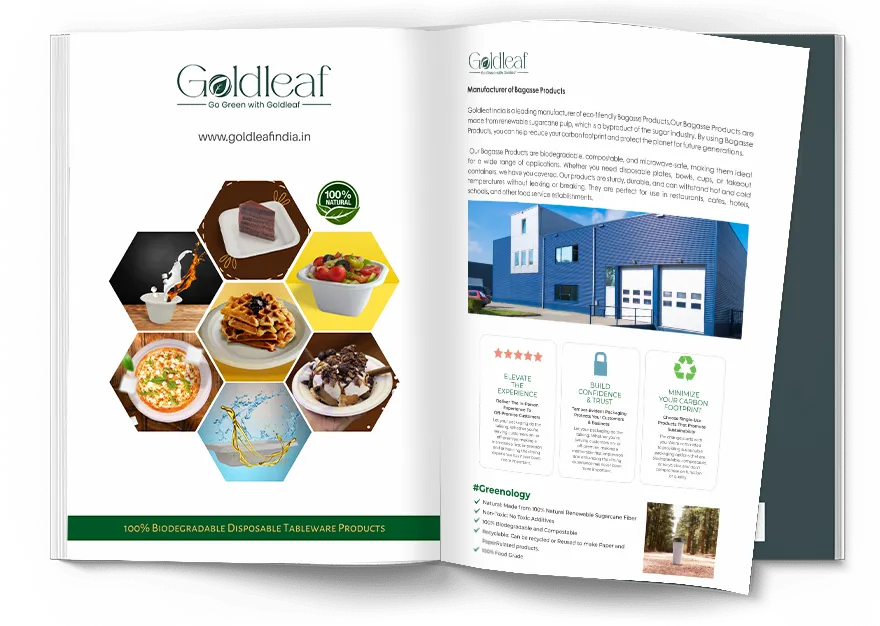Maak contact met ons team

- 1904
Introduction
With plastic pollution becoming an alarming trend globally, companies, as well as customers, are seeking solutions that can replace their current products without affecting quality or convenience. Rising above the material is a bagasse packaging, a biodegradable called the bagasse, made of sugarcane.
In this post, we will find out why bagasse packaging is a better option than conventional plastics and why it is fast emerging as the new standard in food and product packaging.
What Is Bagasse Packaging?

Bagasse refers to the dry, fibrous product that is left over after crushing sugarcane stalks to obtain the juice of the sugarcane. This byproduct is replacing such agricultural waste being discarded or burned with sugarcane packaging made of sustainable and practical sugarcane materials.
It works by first pulping the bagasse and forming them into shaped items such as plates, bowls, and containers and then drying them to make durable, compostable products. This natural material, unlike plastic, does not need petroleum and is compostable.
How Does Plastic Compare to Bagasse?
The major problem with plastic is that it needs hundreds of years to decompose or maybe not. The majority of plastic is disposed of in landfills or the ocean where it poses a threat to wildlife and leaks toxic chemicals into the environment.
Conversely, sugarcane bagasse packaging decomposes naturally in 60 to 90 days of composting conditions. It breaks down into nutritious compost leaving no toxic byproducts. The contrast is stark: while plastic pollutes, bagasse is sustainable.
Bagasse vs Plastic: A Quick Comparison
| Feature | Bagasse Packaging | Plastic Packaging |
| Raw Material | Sugarcane waste (renewable) | Petroleum (non-renewable) |
| Decomposition | 60–90 days (compostable) | 400+ years |
| Toxin Emission | Non-toxic, food-safe | Can leach harmful chemicals |
| Energy Footprint | Lower (biodegradable production) | Higher (petroleum refining) |
| Environmental Impact | Minimal | High (landfill, ocean waste) |
| Microwave Safe | Yes | No |
Environmental Advantages Over Plastic
Bagasse packaging distinguishes itself with remarkable eco-benefits:
• Renewable Resource: Bagasse is made of a renewable crop (sugarcane) and will reduce the use of virgin resources, and lower its carbon footprint than plastic, which is petroleum-based.
• Biodegradable and Compostable: Bagasse food packaging breaks down in natural decomposition in less than weeks in a composting environment, and breaks down into nutrient rich soil and supports a circular economy. By contrast, plastics can take centuries in the environment.
• Reduced waste: The utilization of bagasse involves re-using sugar industry waste material, removing tons of material that are otherwise deposited in landfills.
Benefits of Bagasse Packaging

Bagasse offers a range of benefits that make it ideal for modern packaging needs, particularly in the food and hospitality industry:
• Biodegradable and Compostable: Bagasse food packaging is 100% compostable at home or in industrial composter. This means less waste in landfills, and a better planet.
• Resistant to heat and water: Suitable for hot and cold foods, sugar cane food packaging can keep soups, sauces, and frozen items without any stress. Not like plastic, it won’t buckle or off-gas unhealthy chemical substances.
• Microwave & Freezer Safe: Bagasse takeaway container is microwave safe and safe to freeze, very convenient and flexible for restaurants, and households usage.
• Non-Toxic & Food Safe: Being made of natural fibers, these containers are chemical-free and free from harming consumers.
• Made from Agricultural Waste: Turning sugarcane waste into product, bagasse industry help to prevent the pollution from the agricultural and support the circular economy.
Common Applications of Sugarcane Packaging
From cafés to catering events, bagasse packaging is being embraced across sectors:
• Restaurants use bagasse takeaway containers and bowls for dine-out orders.
• Supermarkets prefer sugarcane food packaging trays for fresh produce.
• Event organizers choose eco-friendly sugarcane takeaway containers to reduce single-use plastic waste.
Retail brands are integrating biodegradable options into their packaging lines for sustainability-conscious customers.
Business Benefits
• Enhanced Brand Image: Switching to sustainable packaging signals a commitment to environmental responsibility and an advantage for modern branding.
• Regulatory Compliance: As many regions ban or restrict single-use plastics, bagasse packaging helps businesses stay compliant.
• Customization: Bagasse containers can be printed and branded, promoting both sustainability and business identity.
• Waste Footprint Reduction: Compostable packaging allows businesses to contribute less to landfill accumulation.
Final Thoughts
As environmental concerns grow, adopting sustainable practices isn't just a trend—it's a necessity. Bagasse packaging provides a safe, natural, and biodegradable alternative to plastic, without compromising on functionality. Whether you're a restaurant owner, food vendor, or eco-conscious consumer, switching to sugarcane bagasse packaging is a smart, forward-thinking choice. Let’s move away from plastic and embrace packaging that gives back to the earth instead of polluting it.
People Also Ask
1. What is bagasse packaging?
Eco-friendly packaging made from sugarcane waste, used as a sustainable alternative to plastic.
2. What are the benefits of bagasse packaging?
It’s biodegradable, compostable, heat-resistant, food-safe, and made from renewable sugarcane fiber.
3. What are the disadvantages of bagasse packaging?
Higher cost than plastic, limited moisture resistance, and best suited for short-term use.
4. What is the best use of bagasse?
Ideal for making compostable food containers, plates, bowls, and eco-friendly packaging.
5. What exactly is bagasse?
Bagasse is the dry fiber left after extracting juice from sugarcane—commonly used for packaging and paper.
© 2024 , Goldleaf ,
Alle rechten voorbehouden.
Made & Managed by Lightlink Solutions




